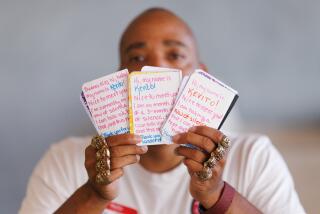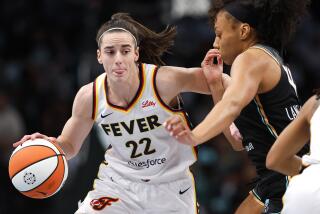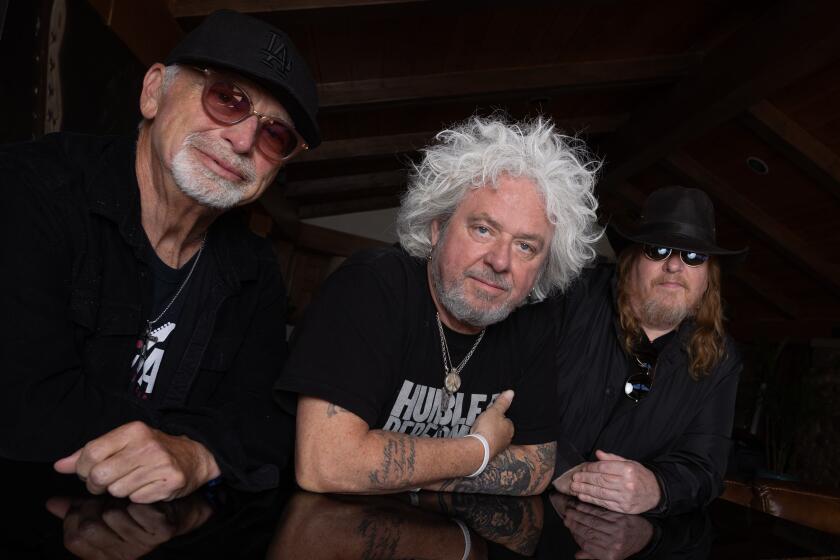Gary Clark Jr. plays every shade of the blues
Eight months ago at private Hollywood venue the Sayers Club, Texas guitarist Gary Clark Jr. stood on a tiny stage with his backing band and performed to a small but capacity crowd of handpicked music industry insiders.
The 28-year-old player, who came up in a storied Austin blues scene that takes its music seriously, had just been signed by Warner Bros. Records, after years of being managed by his mother from the familyâs kitchen table and releasing music independently. Last week, Warner released his major label debut, âBlak and Blu.â
Though Clark had established himself in Texas and had just released a new four-song EP, most were there as much out of curiosity as drooling anticipation. Then the lanky musician and his band started playing, and within moments the room seemed to fill with fresh oxygen as he tore through âBright Lights,â a furious, electrified Clark original that uses as its foundation a variation on a lyric from a Jimmy Reed blues classic. He confidently ripped through his song âWhen My Train Pulls Inâ as though heâd been doing this for decades.
PHOTOS: âWho Shot Rock & Rollâ
When he strummed the distorted opening riffs of Jimi Hendrixâs âThird Stone From the Sun,â it felt like an incitement, a dare, an invitation to compare, especially when he bridged it with his own work, âIf You Love Me Like You Say.â
By the end I understood something vitally new about a song Iâve air-guitared to for a few decades now, and after the set was done the music supervisors, late-night talk show bookers, journalists and others had Gary Clark Jr. on the brain: a cocksure instrumentalist whose talent transcended genre, and whose emotion bled through his fingers and his voice.
A similar thing happened at Coachella, except on a much larger stage, where Clark controlled a crowd whose tastes for American blues extend little further than barbecue sauce commercials. There, âThird Stoneâ connected a dead legend and a young protĂŠgĂŠ, and the eardrums of young fans reared on hip-hop and techno got dented by different kinds of vibrations. He did the same at Bonnaroo in Tennessee later in the season to a different kind of crowd, to similar raves. Ditto Lollapalooza in Chicago. Last month he joined Jay-Z onstage as part of the rapperâs inaugural Philadelphia music festival, Made in America. Clark will perform three sold-out nights at the Troubadour from Nov. 13-15.
Then again, heâs got a lot of experience up there. Clark said during an interview last week that his debut onstage performance was at the behest of Clifford Antone, owner of storied Austin blues club Antoneâs. âIt was historical,â said Clark. âEverybody wants to be on that stage. And Cliff was like, âYou want to get up there and play?ââ On the stage waiting for him was Howlinâ Wolfâs guitarist Hubert Sumlin and a few other legends.
PHOTOS: Celebrities by the Times
âMy first time,â he says, his voice filling with wonder, âwas with Hubert, Pinetop Perkins, and James Cotton â âSuperharp.â Iâm 15 years old. It was a trip.â
Last Monday morning after a long night performing at Neil Youngâs Bridge School Benefit in San Francisco, Clark and band were already rehearsing on a Burbank stage about the size of the Sayers Clubâs. This one would soon face a bigger audience, though: viewers of âThe Tonight Show With Jay Leno.â His band rolling with a three-piece horn section, the guitarist with skinny, nimble fingers was ripping through âAinât Messin âRoundâ in anticipation of the show-ending performance. It was the same day that Clarkâs âBlak and Bluâ was released, and the artist had a full schedule. More rehearsals, a photo shoot, the Leno performance, and a release party in Hollywood.
âThe Tonight Showâ studio was empty save Clark, his band and management, recording engineers and Lenoâs music segment producer Barbera Libis, but a thrill still cascaded through the room as he soundchecked the song.
When he was done, Clark, wearing a flat-brimmed Texas hat, escaped to the NBC lot for a smoke before sitting down in his dressing room to relax before a second round of rehearsals.
Clark, who still lives in Austin, has a calm, composed demeanor that belies the fact that heâs the obvious rock star in any room he enters. He says that despite his obsession with the blues as he was learning the guitar, he was falling in love with lots of music simultaneously, from Tupac Shakur and the Notorious B.I.G. to Stevie Wonder and Marvin Gaye to Nirvana and Pearl Jam. When he sat down with Warner Bros. executives to talk about his album, he insisted on playing them a stylistic variety of his music, not just the blues-based numbers.
âI was pretty hardheaded about not sticking to one certain thing,â he said of an early meeting with, among others, Warner Bros. Records Chairman Rob Cavallo and producer Mike Elizondo (best known as a hip-hop bassist, producer and co-writer of Eminemâs âThe Real Slim Shadyâ), both of whom produced songs on âBlak and Blu.â âFolks wanted to have a straighter, more focused album, like a blues rock type of thing. Everyoneâs been talking about the Black Keys, stuff like that. I dig them, and I had this background of being a blues artist, but at the same time the things Iâd been recording and playing were all over the place.â
PHOTOS: âWho Shot Rock & Rollâ
Thus, âBlak and Bluâ is more than a blues rock record, even if it features some essential blues lines and builds nearly every song using it as a foundation. Within its 13 tracks are hard-rock songs and more contemporary-sounding rhythm and blues. He touches foot-stomping country blues on âNext Door Neighbor Blues,â and suggests a more rustic John Legend on âThings Are Changinâ.â The albumâs biggest departure is Clarkâs âThe Life,â a bouncy, introspective contemporary R&B; jam sure to rile the traditionalists among his fan base. Combined, the record suggests sounds that include mid-1970s Rolling Stones, groove-filled Curtis Mayfield and hard-hitting Otis Redding-styled soul jams.
His intention, he said, was to be straight with his label and his potential fan base from the start. âI told them, I donât want to get put in this box right away, and then branch out into all the other things that I love as well later on, and those be [considered] the weird albums. I think itâs really important to throw it all out there now, and get a full-scope idea of whatâs actually going on.
âAfter a few conversations, they were cool with it,â he concluded.
They had little choice. Clark says that by the time he sat down with Warner Bros., heâd already been approached by major labels. They experienced something akin to what Lenoâs music producer Libis saw the first time she came across him. She called Clarkâs booking âa no-brainer,â adding that sheâs only felt a similar certainty a few times in her years booking music â among them, as Norah Jonesâ debut album was rising, and when the Civil Wars broke out of the South in 2011.
But such intuition doesnât mean much in the scheme of things. If fans arenât buying what Clark is selling, such success wonât happen.
As an example of the battle he faces, Clark tells the story of watching a clip of blues-funk player Johnny âGuitarâ Watson being interviewed by Don Cornelius on âSoul Train.â Slipping into a practiced, slow-drawled impersonation, Clark mimicked the host observing that Watson was considered a blues artist, but was trying out new sounds.
Recounts Clark: âJohnnyâs like, âYeah, man, blues ainât too popular now, you know, so Iâm trying to do different things, finding different grooves, and experimenting.ââ
Clark has a similar reflex on âBlak and Blu,â and delivers it with an equal sense of adventure.
PHOTOS AND MORE:
PHOTOS: Iconic rock guitars and their owners
The Envelope: Awards Insider
PHOTOS: Unfortunately timed pop meltdowns
More to Read
The biggest entertainment stories
Get our big stories about Hollywood, film, television, music, arts, culture and more right in your inbox as soon as they publish.
You may occasionally receive promotional content from the Los Angeles Times.










